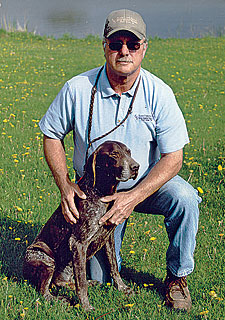The latest training techniques for pointing breeds.
By James B. Spencer
 This tip is from Al Harmeyer of Krystal Creek Kennels, Inc., W2349 Amsterdam Road, Cedar Grove, WI 53013; (920) 668-8619; Web site www.krystalcreekkennels.com; e-mail kckennel@wi.rr.com. Al has been training all sporting breeds professionally for over 20 years, specializing in training pointing breeds for hunting and hunting tests. He is a North American Versatile Hunting Dog Association senior judge and clinic leader. He breeds German shorthaired pointers and Small Munsterlanders. |
"Honestly," Al said, "I can't imagine hunting a pointing dog without an e-collar. Even well-trained dogs have untrained moments that can lead them into unsafe situations. When that happens, the e-collar gives me an immediate way of regaining control."
Al stressed that before you can use an e-collar effectively while hunting, you must first prepare your dog for it during off-season training sessions. You should use it only to reinforce commands he already knows, so he can learn how to turn off the juice, so to speak, by obeying. You should never use it in an attempt to "teach" a command your dog doesn't know.
"The two most important commands," Al said, "are 'here' and 'whoa.' If you teach these well and then use the e-collar to reinforce them in training, your dog'll be a great hunting buddy. Of course, you should also e-collar-reinforce the other basic commands as he masters them."
Al prefers an e-collar with variable intensity, momentary and continuous stimulation, a beeper accessory and the ability to add a second e-collar to the same transmitter for handling two dogs at once.
Variable intensity gives you the ability to adjust the stimulation level to the needs of each situation. For example, you can use a higher level when your dog chases deer, skunks and so forth, and a lower level for reinforcing known commands. Momentary stimulation allows you to send your dog a quick reminder lasting only a fraction of a second, even if you accidentally hold the button down too long. Continuous stimulation sends your dog a more insistent message when he needs one.
"Momentary stimulation asks the dog," Al said, "but continuous stimulation tells him."He listed several situations when you should not push the transmitter button on your e-collar. First, you should use it sparingly, if at all, during your dog's bird contacts. If your dog associates stimulation with birds, he may become bird-shy and start blinking (avoiding birds).
| Don't Miss More Tips | 

Find tips for your retriever here, and your spaniel here.
|
|
"In general," he said, "during bird contacts, the bird is the best teacher."
If your dog gets into an altercation with another dog, you shouldn't try to break it up with the e-collar. Your dog will attribute the stimulation to the other dog and therefore fight more furiously.
You should never use the e-collar when your dog is out of sight, for you don't know what he's doing. He might be on point. He might be chasing a cripple someone else shot and abandoned. He might be confused and heading in the wrong direction. And so on.Al mentioned several common mistakes owners make with e-collars. Worst of all, some try to use it as a magic wand while hunting, without adequate preparation in training sessions. Very much of this can ruin an otherwise good prospective bird dog. Then, too, some use too high a level of stimulation for their dogs or for the specific situation, both of which can intimidate the dog.
"The e-collar, used properly, is a wonderful tool, but used improperly it can ruin a dog," Al continued. "If you use it consistently well during off-season training, you will have a more pleasant hunting season--and a more productive one."






